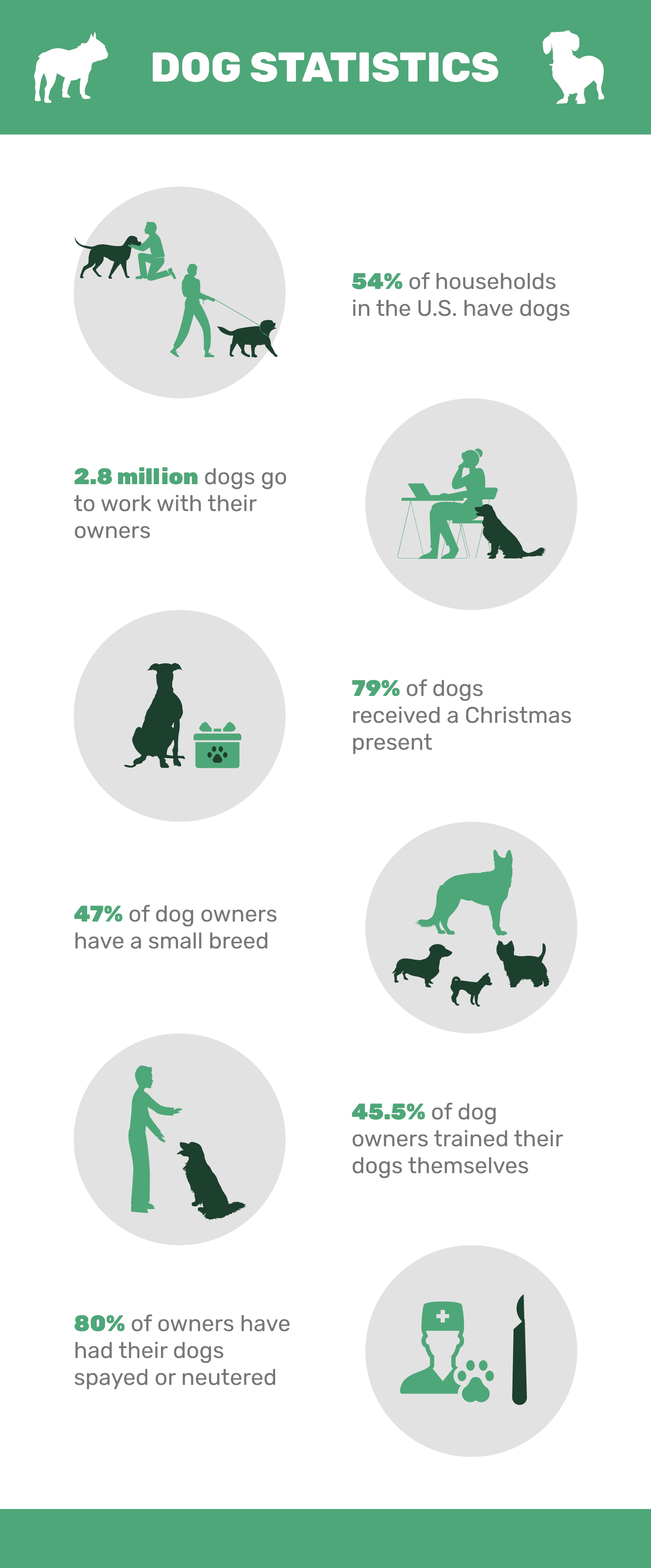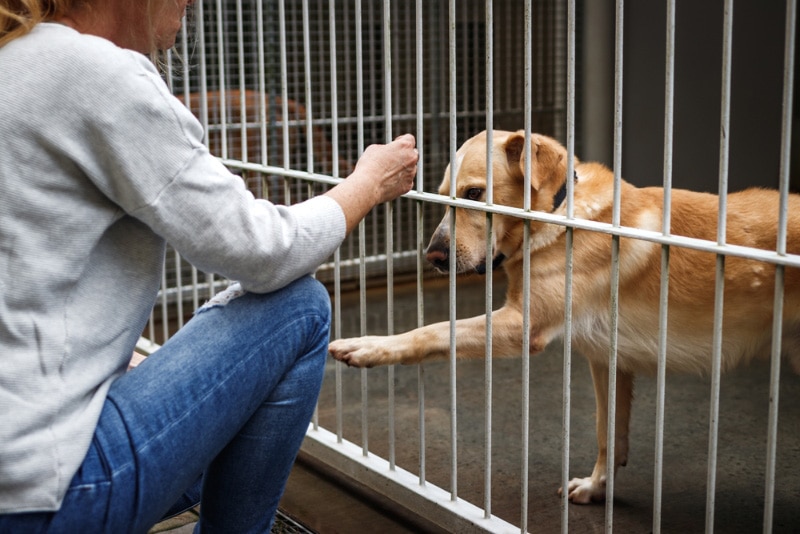
20 Dog Statistics All Pet Lovers Should Know in 2024 – Dogster
Note: This article’s statistics come from third-party sources and do not represent the opinions of this website.
Dogs have been people’s favorite pets for thousands of years. They provide unconditional love and support, help relieve stress, and improve mental health. We know how important dogs are, so we compiled 20 important statistics all about our best friends.
Hopefully, you’ll discover new facts that might help answer some of your questions, or maybe you’ll just learn something new!


The 20 Dog Statistics
- 8% of dog owners took their dogs to obedience class.
- 73% of dog owners used some kind of training method.
- 45% of dog owners trained their dogs themselves.
- Pet products reached $103.6 billion in sales.
- 43% of dog owners bought premium dog food.
- 86% of pet owners purchased pet products online.
- More than 90% of dog owners took them to the vet for at least one visit.
- 80% of owners have had their dogs spayed or neutered.
- 59% of dogs were rated as obese in the U.S. in 2022.
- 3 million dogs enter animal shelters every year in the U.S.
- 6 million dogs are adopted and 670,000 dogs are euthanized.
- 66% of households in the U.S. own at least one pet in 2024.
- 54% of households in the U.S. have dogs.
- 31% of millennials are pet owners.
- 43% of dogs sleep on their owners’ beds.
- 25 million dog owners take their pups on vacation.
- 8 million dogs go to work with their owners.
- 79% of dogs received a Christmas present.
- The Labrador Retriever has been the most popular dog since 1991.
- 47% of dog owners have a small breed.




Dog Training Statistics
1. 8% of dog owners took their dogs to obedience class.
(AKC)
Previous years have seen just 4% of owners taking their dogs to obedience training, but the increase in dog ownership due to the COVID-19 pandemic has also seen an increase in training.


2. 73% of dog owners used some kind of training method.
(AKC)
Just in 2018, 57% of dog owners used some type of training method, so that’s an increase of 16%.
3. 45% of dog owners trained their dogs themselves.
(Vetstreet)
In a survey with 1,800 dog owners, it was almost an even split: 45.5% did the training themselves, while 46.7% took their dogs to class.




Pet Products/COVID-19 Statistics
4. Pet products reached $103.6 billion in sales.
(APPA)
This is the highest level of spending in the history of the pet industry, and it’s due to a significant increase in pet ownership during COVID-19.
(Pet Food Processing)
The majority of the premium food is organic and is primarily being purchased by millennials (the generation born between 1981 and 1996).


6. 86% of pet owners purchased pet products online.
(AKC)
This is up 20% from before the COVID-19 pandemic. This also means in-person shopping has gone down 20%.


Dog Health Statistics
7. More than 90% of dog owners took them to the vet for at least one visit.
(AKC)
The increase in dog ownership and more people at home spending time with their dogs means more care.


8. 80% of owners have had their dogs spayed or neutered.
(AKC)
This is an important one because it helps reduce homelessness, which will reduce the number of euthanasia cases that occur.
9. 59% of dogs were rated as obese in the U.S. in 2022.
(APOP)
This equals about 50 million dogs that are too heavy, which can lead to health issues.


Dog Shelter Statistics
10. 3 million dogs enter animal shelters every year in the U.S.
(ASPCA)
Luckily, about 620,000 dogs do end up back with their owners, but 3.3 million is still far too many.


11. 6 million dogs are adopted and 670,000 dogs are euthanized.
(ASPCA)
These numbers are due in part to spay/neuter issues but also because people don’t always realize the cost and responsibility of owning a dog.
12. 66% of households in the U.S. own at least one pet in 2024.
(AVMA)
Pet ownership numbers have declined over the last few years, but 89.6 million U.S. households have at least one pet, with nearly 90 million dogs and 60 million cats.


General Dog Ownership Statistics
13. 54% of U.S. households have at least one dog.
(APPA)
Dogs outnumber all other pets as the most popular pets in North America. Cats come in second at 35%.


14. 31% of millennials are pet owners.
(APPA)
After millennials, baby boomers (born between 1946 and 1964) come in second at 29%, generation X (born between 1965 and 1980) are at 26%, and lastly, generation Z (born between 1997 and 2012) are at about 14%.
15. 43% of dogs sleep on their owners’ beds.
(APPA)
We love our dogs, so this one probably doesn’t come as much of a surprise. We enjoy a cuddle just as much as our dogs do, and we both mutually benefit from spending time together.


16. 25 million dog owners take their pups on vacation.
(APPA)
It’s quite possible that this number would be higher if there were more pet-friendly hotels and travel was more commonplace.
17. 8 million dogs go to work with their owners.
(APPA)
People need a work environment that encourages or is okay with dogs being brought into work. This number would probably be much higher otherwise.


18. 79% of dogs received a Christmas present.
(APPA)
We love our dogs, and they are most definitely a part of our family, so we give them gifts on important days.
19. The Labrador Retriever has been the most popular dog since 1991.
(AKC)
The Lab has topped the chart as the most popular dog for 30 years straight! In 2021, the German Shepherd was the second most popular, and the Golden Retriever was third.


20. 47% of dog owners have a small breed.
(AKC)
This makes small dogs the most popular size in North America. It’s due in part to the fact that they cost less to take care of compared to large dogs, both in food and with certain veterinary bills.


Frequently Asked Questions
How much will the pet industry continue to grow?
While the industry is currently sitting at $103.6 billion, it’s expected to almost triple by 2030 to $275 billion! This has everything to do with the increase in pet ownership due to the pandemic. (Morgan Stanley)
How many pet owners believe that pets bring happiness?
We know how much our pets make us happy, and 68% of pet owners believe the same. To add to that, 73% of families believe that dogs bring them closer together. (APPA)
How much do dog owners believe that our dogs are good for our health?
About 80% of dog owners believe that pets are quite beneficial to their health, and another 62% believe that they contribute to lowering stress. (APPA)


How many people plan on getting a pet?
Within the next 5 years, 65% of 18- to 34-year-olds plan on adding a new pet to their households. This will see an increase in pet ownership of 14% by 2030. (Morgan Stanley)
How much are we spending on our pets?
In 2020, the average amount spent on pets was about $980. This number is expected to increase up to $1,292 by 2025 and then further up to $1,909 by 2030. (Morgan Stanley)
How important are our pets?
About 43% of 18- to 34-year-old pet owners are actually willing to go into debt to pay for their pet’s medical expenses. This number goes down as age goes up: 36% of 35- to 54-year-olds and 31% of 55 and up feel the same. (Morgan Stanley)




Conclusion
Our dogs are not just pets—they are essential members of our families. These statistics just highlight how important they are and how much our relationships with them have changed, particularly recently due to the pandemic. In times when people have felt isolated, our dogs have given us necessary companionship.
Due to this companionship, many of us prioritize their health and happiness, sometimes even at the expense of our own. It’s expected that we’ll see a dramatic increase in these kinds of statistics as time goes by. Better food, health concerns, and more training and entertainment are all important factors in taking care of our dogs—and they’re worth every cent.
You may also be interested in:
Featured Image Credit: Tatyana Vyc, Shutterstock



